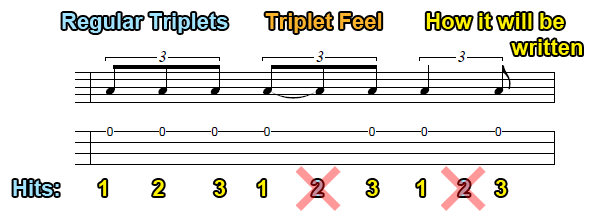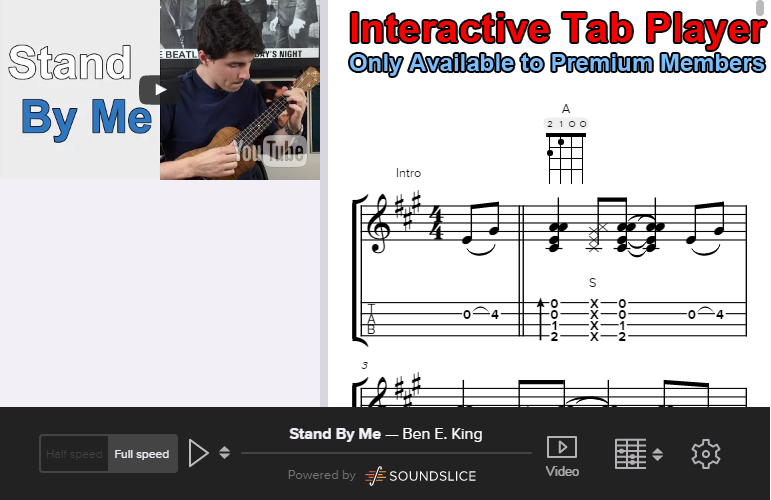Swung Vs. Straight Rhythm
Tab Play Along for Performance Exercise
The Difference Lies in the "Feel"

A common stylistic approach used in Jazz and Blues Shuffles is to play with a swung rhythm. But, what exactly does it mean to "swing the rhythm"? That's what we'll be answering in this lesson.
Reviewing the Fundamentals
Before we dive in, it's important to have a general understanding of rhythmic notation, specifically as it pertains to eighth notes and eighth note triplets. If you are new to these concepts, I'd highly encourage you to start with our lesson on understanding rhythmic value (note and rest durations), before moving forward with this tutorial.
Below, I've posted a quick recap covering the rhythmic value of eighth notes and eighth note triplets; as well as, the method used to count the rhythms.
Eighth Notes
Eighth notes last for half a beat. They resemble quarter notes, but have a flag attached to the stem. Beams, a thick horizontal line used in place of flags, connect groups of two or more notes to form a metrical unit (a fancy way to say: a beat). Notice how the beam in the picture connects two eighth notes. Beamed groups are much easier to read than a cluster of flagged notes.
Eighth notes are counted: 1 & 2 & 3 & 4 &.

Listen to Eighth Notes being played alongside a metronome in 4/4.

Eighth Note Triplets
Triplets are a group of three notes that occur in the amount of time that two notes of the same value are usually played. In other words, if we had 1 bar of eighth notes (8 notes), we could subdivide the beat into 3 equal parts by using eighth note triplets (as shown below). Triplets are always grouped in 3 and have the number "3" displayed above the group.

Triplets can be counted: 1, 2, 3 or Trip-l-et.

Listen to Eighth Note Triplets being played alongside a metronome in 4/4.

Swung 8ths vs. Straight 8ths
As we saw and heard in the audio clip above, when playing straight eighth notes, we are dividing the beat exactly in half; where each note lasts an equal length of time. On the contrast, with swung eighth notes, the second eighth note in each pair occurs two-thirds of the way through the beat. This is equivalent to playing on the first and third hits of an eighth note triplet. Let's take a closer look.

We can clearly see that we hit on beat one of the triplet, hold (tie) into beat 2, and hit again on beat 3. This creates a longer duration for the first note (lasting 2/3 of the beat), and a shorter duration for the second note (lasting 1/3 of the beat).
Listen to Swung Eighth Notes being played alongside a metronome in 4/4.
Indicating a Triplet Feel in Sheet Music
When a piece of music is written with a triplet feel (swung eighth notes), the composer/arranger will notate this at the beginning (or the section in which the feel changes) of the music. You will see this symbol, which indicates that eighth notes should be played with a swung feel:

Where to Go Next?
Now that you have a thorough understanding of the difference between swung and straight eighth notes, it's time to start practicing both feels! I'd recommend to begin with the exercises and performance tune taught in this lesson. After that, here are 4 song recommendations for continued practice:
Songs Using Swung Eighth Notes
Fingerpicking Etude no. 10: "DayDreaming" - In this etude, you’ll learn a cute sounding melody that is played with a swung rhythmic feel.
"SpongeBob SquarePants Theme" - This is a great beginner fingerstyle piece that can be easily learned in an hour.
Songs Using Straight Eighth Notes
Our First Song - In this lesson, we will be combining fingerpicking and strumming to create and play our first tune!
Fingerpicking Etude no. 5 - Two beautiful melodies that are fingerpicked entirely using Travis picking.
Article by: Andrew Hardel

